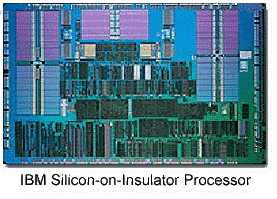Bedrijven als Intel, AMD, VIA en Transmeta doen hun uiterste best om meer en meer snelheid uit hun ontwerpen te slepen. Helaas begint op dit moment de natuurkunde tegen te werken, het wordt namelijk steeds moeilijker om de chips te verkleinen. Er worden tijdelijke oplossingen uit de kast getrokken zoals het gebruik van koper, maar zo'n beetje alle analisten zijn het er over eens dat men nooit efficiënt onder de 0.10 micron kan produceren met de huidige methodes. IBM heeft daarvoor een oplossing bedacht: Silicon-On-Insulator, een techniek die het mogelijk moet maken om over een paar jaar 5GHz processors te kunnen maken die ook nog eens zuinig zijn met stroom. SysOpt.com heeft er een artikel over geschreven, waarin wordt uitgelegd waarom SOI nodig is, wat de voordelen zijn en hoe het tot stand is gekomen:
The diagram above represents a MOS circuit (left) as compared to an SOI circuit (right). The MOS circuit is slower because a capacitance develops between the impurity layers and the silicon substrate. This boundary area is known as the junction capacitance layer. As noted earlier, a MOS circuit must spend a large amount of its operational time discharging and recharging this capacitance. In comparison, the SOI circuit employes silicon oxide layered over the pure silicon substrate. The SOI circuit's capacitance will be negligible since the silicon oxide provides an efficient insulation barrier. The junction capacitance area is eliminated by SOI, thus the transistor will be able to operate faster since the charging process is eliminated.
[...] IBM laboratory testing shows SOI based processors feature a 20-25% improvement in transistor cycle time compared to similar CMOS engineered chips. Performance gains are averaging 25-35% when SOI is employed. Silicon-on-Insulator has also proven to be useful for low power situations. SOI manufactured processors require an average of 40-50% less power than their CMOS counterparts.
In 2002 zou de techniek op de markt moeten verschijnen. Motorola en Compaq (Alpha) hebben al SOI chips, respectievelijk de G4e en de 21264E. AMD is van plan om voor haar 0.13 micron process ook SOI te gebruiken.

